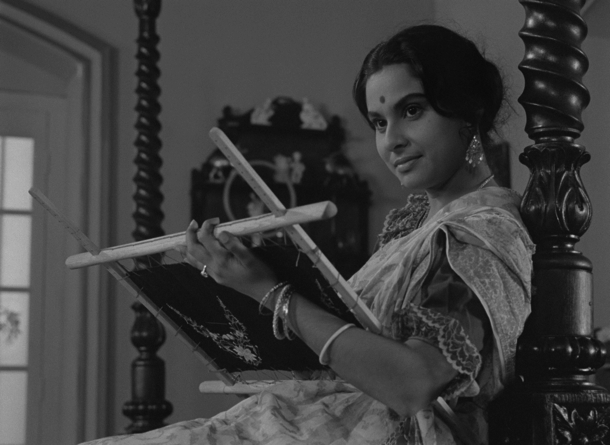




Dir.: Satyajit Ray | Cast: Madhabi Mukherjee, Soumitra Chatterjee, Shailen Mukherjee | India 1964; 117 min.
Another story of female alienation, set in Kolkata in the early 1880s and based on the short story “The Broken Nest” by Rabindranath Tagore. Ray uses utmost candour in this screen version, without betraying any of Tagore’s intentions. Charulata (M. Mukerjee) is the wife of Bhupati (S Mukerjee), who publishes a newspaper “The Sentinel”.
Feeling that his well-educated and elegant wife is lonely, Bhupati invites his older brother Umapada and wife, Manda, to come and stay. But they fail to alleviate his wife’s boredom so he asks his younger cousin Amal (S Chatterjee) into the household. Both share a passion for literature and the relationship becomes more intimate. Bhupati, submerged in his masculine world of politics, is unaware of this relationship. Amal, feeling guilty and threatened by Charulata’s intellect and his feelings for her, abruptly breaks off his relationship with disastrous consequences.
Very much in the style of the Japanese director, Yasujiro Ozu (An Autumn Afternoon), this beautifully told domestic drama offers a pared-down, understated portrait of family life in nineteenth century India. Even in 1964, the role of the Indian woman of Charulata’s class, had not changed that much from the 1880s – many female viewers cried openly after the premiere and Ray was aware of the tension his film would create. Strangely, the Cannes Film Festival rejected the film but it was shown in the summer of 1965 at the Berlinale, were Ray won the “Silver Bear” for best director.
Despite the simplicity of the narrative, Charulata’s passion is still very much in evidence and Madhavii Mukherjee is still remembered today for her luminous performance. The monochrome camera glides through the big house with its imposing clocks and furniture as atmospheric sounds drift in from the street: the cries of street vendors and delicate birdsong from the garden.
Although surrounded by a legion of of capable servants, Charulata is isolated until Amal appears. But despite his artistic sensitivity and feelings for her, Ray illustrates how he is still a man in a man’s world – not so far removed from Bhupati – and when challenged he is surprised that Charulata’s opinions differ (understandably) from his views and literary taste.
Amal is shown as a coward with feet of clay, a traitor to his own ideas. Bhupati loves his politics and uses his power to exercise to , his ego rather than to understand people. In the end, the question of reconciliation is left open: and the final frame is illuminating.
Penelope Houston summed it up in 1965 when she wrote in ‘Sight and Sound’: “…the interplay of sophistication and simplicity is extraordinary”. And for Satyajit Ray this would remain the favourite of his film, “the one he would make again exactly the same”. Today, CHARULATA still feels modern. AS
SCREENING IN THE CLASSICS STRAND | CAIRO INTERNATIONAL FILM FESTIVAL 2024